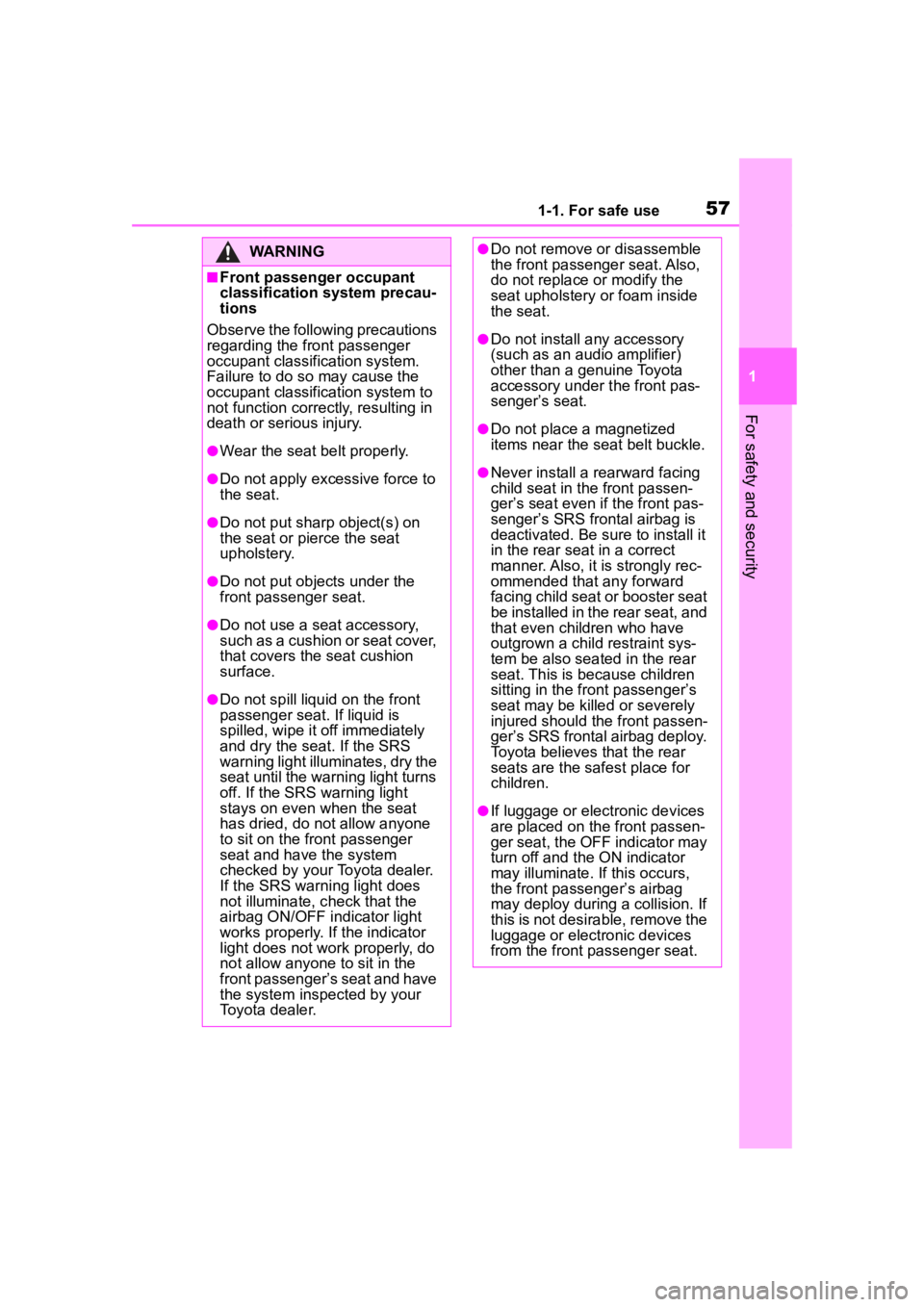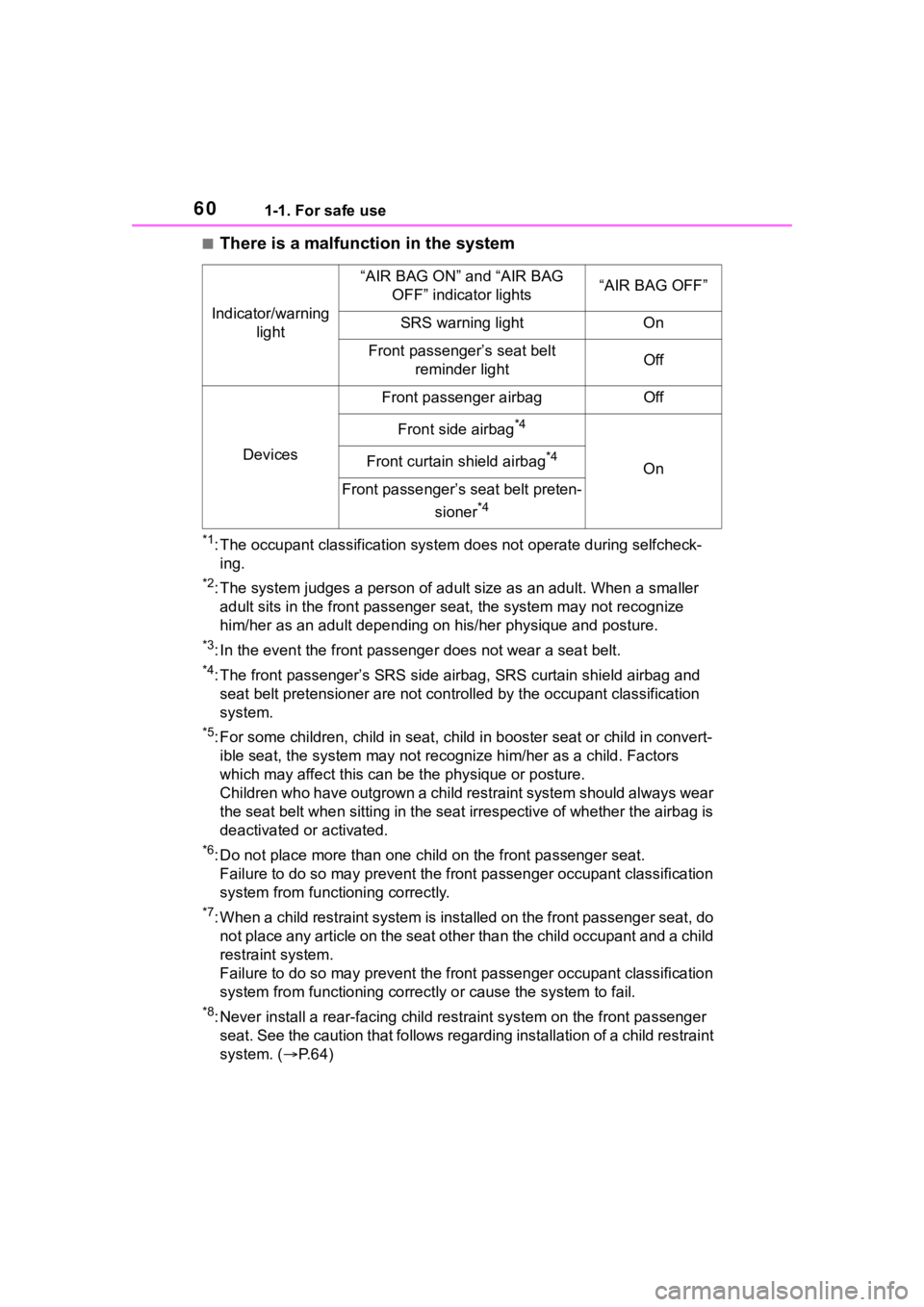2023 TOYOTA 86 deactivate airbag
[x] Cancel search: deactivate airbagPage 46 of 449

461-1. For safe use
■If the passenger’s frontal airbag
OFF indicator illuminates and
the ON indicator turns off even
when the front passenger’s seat
is occupied by an adult
This can be caused by the adult
incorrectly sitting in the front pas-
senger’s seat.
1 Turn the engine switch off.
2 Ask the front passenger to set
the seatback to the upright posi-
tion, sit up straight in the center
of the seat cushion, correctly fas-
ten the seatbelt, position his/her
legs out forward, and adjust the
seat to the rearmost position.
3 Turn the engine switch to ON.
If the OFF indicator remains illumi-
nated while the ON indicator
remains off, take the following
actions.
1 Turn the engine switch off.
2 Make sure that the front passen-
ger does not use a blanket, extra
seat cushion, sea t cover, extra
seat heater or massager, etc.
3 If wearing excessive layers of
clothing, the front passenger
should remove any unnecessary
items before sitting in the front
passenger’s seat, or should sit in
a rear seat.
4 Turn the engine switch to ON
and wait 6 seconds to allow the
system to complete self-check-
ing. Following the system check,
both indicators turn off for 2 sec-
onds. Now, the ON indicator
should illuminate while the OFF
indicator remains off.
If the OFF indicator still remains illu-
minated while the ON indicator
remains off, ask the occupant to
move to the rear seat and immedi-
ately contact your Toyota dealer for
an inspection.■If the seatbelt buckle switch
and/or front passenger’s occu-
pant detection system have
failed
If the seatbelt buckle switch and/or
front passenger’s occupant detec-
tion system have failed, the SRS
warning light will illuminate. Have
the system inspected by your Toyota
dealer immediately if the SRS warn-
ing light illuminates.
■When to contact your Toyota
dealer
If your vehicle has sustained impact,
this may affect the proper function of
the Toyota advanced frontal airbag
system. Have your vehicle
inspected at your Toyota dealer. Do
not use the front passenger’s seat
while driving the vehicle to your Toy-
ota dealer.
WARNING
■When using a child restraint
system
NEVER INSTALL A CHILD
RESTRAINT SYSTEM IN THE
FRONT PASSENGER’S SEAT
EVEN IF THE FRONT PASSEN-
GER’S SRS FRONTAL AIRBAG
IS DEACTIVATED. Be sure to
install it in the REAR seat in a cor-
rect manner. Also, it is strongly
recommended that any forward
facing child seat or booster seat
be installed in the REAR seat, and
that even children who have out-
grown a child restraint system be
also seated in the REAR seat.
This is because children sitting in
the front passenger’s seat may be
killed or severely injured should
the front passenger’s SRS frontal
airbag deploy. REAR seats are
the safest place for children.
Page 56 of 449

561-1. For safe use
The front passenger’s frontal airbag ON and OFF indicators show
you the status of the front passenger’s SRS frontal airbag. When the
engine switch is turned to ON, both the ON and OFF indicators illu-
minate while the system is checked, after which both indicators turn
off.
After that, one of the indicators illuminates depending on the status
of the front passenger’s SRS frontal airbag determined by the T oyota
advanced frontal airbag monitoring system.
SRS warning light
Front passenger’s seat belt reminder light
“AIR BAG OFF” indicator light
“AIR BAG ON” indicator light
Front passenger occupant classification system
Your vehicle is equipped with a front passenger occupant
classification system. This system detects the conditions of
the front passenger seat and activates or deactivates the front
passenger airbag.
System components
A
C
D
Page 57 of 449

571-1. For safe use
1
For safety and security
WARNING
■Front passenger occupant
classification system precau-
tions
Observe the following precautions
regarding the front passenger
occupant classification system.
Failure to do so may cause the
occupant classifi cation system to
not function correctly, resulting in
death or serious injury.
●Wear the seat belt properly.
●Do not apply excessive force to
the seat.
●Do not put sharp object(s) on
the seat or pierce the seat
upholstery.
●Do not put objects under the
front passenger seat.
●Do not use a seat accessory,
such as a cushion or seat cover,
that covers the seat cushion
surface.
●Do not spill liqui d on the front
passenger seat. If liquid is
spilled, wipe it off immediately
and dry the seat. If the SRS
warning light illumi nates, dry the
seat until the warning light turns
off. If the SRS warning light
stays on even when the seat
has dried, do not allow anyone
to sit on the front passenger
seat and have the system
checked by your Toyota dealer.
If the SRS warning light does
not illuminate, check that the
airbag ON/OFF indicator light
works properly. If the indicator
light does not work properly, do
not allow anyone to sit in the
front passenger’s seat and have
the system inspected by your
Toyota dealer.
●Do not remove or disassemble
the front passenger seat. Also,
do not replace or modify the
seat upholstery or foam inside
the seat.
●Do not install any accessory
(such as an audio amplifier)
other than a genuine Toyota
accessory under t he front pas-
senger’s seat.
●Do not place a magnetized
items near the seat belt buckle.
●Never install a rearward facing
child seat in the front passen-
ger’s seat even if the front pas-
senger’s SRS frontal airbag is
deactivated. Be sure to install it
in the rear seat in a correct
manner. Also, it is strongly rec-
ommended that any forward
facing child seat or booster seat
be installed in the rear seat, and
that even children who have
outgrown a child restraint sys-
tem be also seated in the rear
seat. This is because children
sitting in the front passenger’s
seat may be killed or severely
injured should the front passen-
ger’s SRS frontal airbag deploy.
Toyota believes that the rear
seats are the safest place for
children.
●If luggage or electronic devices
are placed on the front passen-
ger seat, the OFF indicator may
turn off and the ON indicator
may illuminate. If this occurs,
the front passenger’s airbag
may deploy during a collision. If
this is not desirable, remove the
luggage or electronic devices
from the front passenger seat.
Page 60 of 449

601-1. For safe use
■There is a malfunction in the system
*1: The occupant classification system does not operate during selfcheck-
ing.
*2: The system judges a person of adult size as an adult. When a smaller
adult sits in the front passenger seat, the system may not recognize
him/her as an adult depending on his/her physique and posture.
*3: In the event the front passenge r does not wear a seat belt.
*4: The front passenger’s SRS side airbag, SRS curtain shield airbag and
seat belt pretensioner are not c ontrolled by the occupant classification
system.
*5: For some children, child in seat, child in booster seat or chi ld in convert-
ible seat, the system may not recognize him/her as a child. Fac tors
which may affect this can be the physique or posture.
Children who have outgrown a child restraint system should alwa ys wear
the seat belt when sitting in the seat irrespective of whether the airbag is
deactivated o r activated.
*6: Do not place more than one child on the front p assenger seat.
Failure to do so may prevent the front passenger occupant class ification
system from functioning correctly.
*7: When a child restraint system is installed on the front passen ger seat, do
not place any article on the seat other than the child occupant and a child
restraint system.
Failure to do so may prevent the front passenger occupant class ification
system from functioning correctly or cause the system to fail.
*8: Never install a rear-facing ch ild restraint system on the front passenger
seat. See the caution that follows regarding installation of a child restraint
system. ( P.64)
Indicator/warning
light
“AIR BAG ON” and “AIR BAG OFF” indicator lights“AIR BAG OFF”
SRS warning lightOn
Front passenger’s seat belt reminder lightOff
Devices
Front passenger airbagOff
Front side airbag*4
OnFront curtain shield airbag*4
Front passenger’s seat belt preten-
sioner
*4